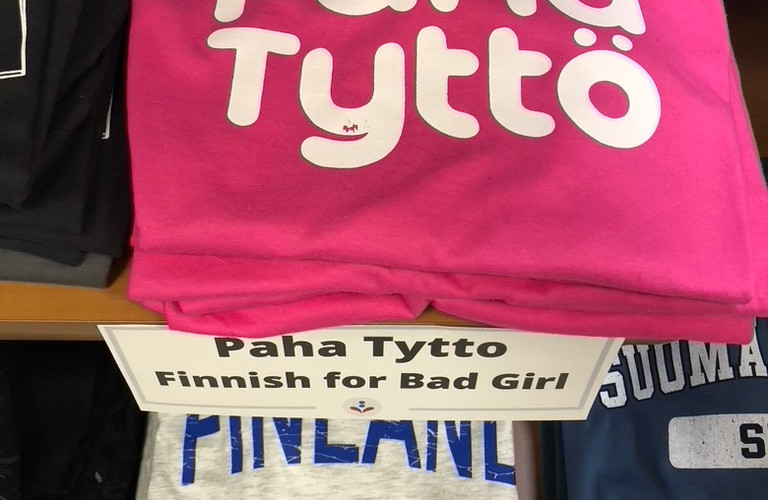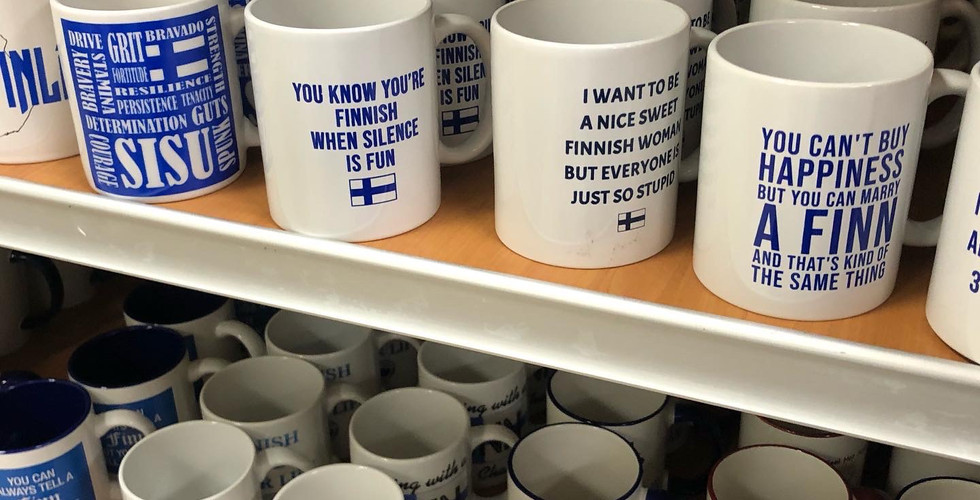Making it to the Finnish line: my visit to Michigan's UP
- Elizabeth Peterson

- Jul 19, 2022
- 9 min read
Updated: Feb 17, 2023
Last month I had the privilege of paying a visit to Michigan, thanks to the efforts and generosity of my host, Dr. Kathryn Remlinger, and her former employer, Grand Valley State University*. The trip was supposed to happen in the spring of 2020. I don't think I need to explain why it didn't. Better late than never, as they say.
I have been to the lower part of Michigan many times, but this trip was extra exciting because it was my first visit to the Upper Peninsula, a place that is fabled in my mind not only because I have a few good friends from the region, but because I live in Finland. The UP (pronounced "you pee"), along with regions along the US/Canada border, are important in the Finnish collective conscious because this is where lots and lots of Finnish migrants ended up in the early 1900s. In fact, many Finns living in Finland will be quick to tell that they have a great aunt or uncle or someone in their family who moved to this region 100 or so years ago. According to Gary Kaunonen's book Finns in Michigan, there were 74,229 foreign and American-born Finns in Michigan by 1930.
People in the UP proudly refer to themselves as "Yoopers," a term derived from "the UP." They speak a distinct variety of US English called "Yooper English," which is the topic of the book Yooper Talk, by Dr. Kathryn Remlinger. I myself am not a researcher of the UP, so I won't be writing any academic papers or journal articles about this visit. What I will do is write about my observations and insights here in this very blog. If you want to read more about the region from people who actually do research there, please take a look at the brief bibliography at the end of this post.
How different is the UP? It's different!
First of all, how different is the UP from lower Michigan? In my limited experience, it is decidedly different. People from the UP have a special name for people from lower Michigan: trolls. Why? Because they live "below," that is, south of the the Mackinac Bridge, the architectural wonder that connects lower and upper Michigan through a 5-mile/8-kilometer span. This is the only way to get to the UP via Michigan by car. Otherwise, it's a flight, a ferry, or you have to cross state lines and go all the way around Lake Michigan to Illinois and on up through Wisconsin. Our drive from lower Michigan to our ultimate destination in the UP, the Keweenaw Peninsula, took 12 hours (including stops for lunch, etc.) So you get the idea: the UP is far away both geographically and psychologically. It's just different. There is a different atmosphere, a wilder landscape, and the people who populate the region are testimony to a different background and shared experiences. Today, the population is mostly white and of a European background. Some 7.5 percent of the local population is Native American, mostly Ojibwe.
We drove by car to the Keweenaw Peninsula, which juts up out of the upper northwestern part of the Upper Peninsula into Lake Superior (here is a map; see the part in red on the image to see the region I am referring to). The farther you go into this part of the UP, the more reminders you get that you are entering into Finnish immigrant territory. For example, look at the name of this town and lake along Highway 41:

There are other reminders, too, like the names on businesses and street signs.

Once we got past Marquette, and then onto our final destination, the neighboring cities of Houghton and Hancock, it's full-on Finn. Here are a few glimpses of the sights.
See? Finnish words, like hakkapeliitta in a sign for a cross-training gym in Houghton, the Suomi Cafe (which is pronounced "soo-me" in the local English), names like Risto at Risto's Hardware store in Hancock, and the treasure trove known as Touch of Finland in Marquette. So pretty much everywhere you go, there are reminders that there have been a lot of Finnish people who settled the area, and this background is still very much a part of the local vibe and overall character.
This history has been absorbed, integrated, and is acknowledged and celebrated in various ways that have taken on local meaning. One of many examples is the celebration of St. Urho's Day, a celebration having to do with grasshoppers and a would-be Finnish saint, all very much part of local lore but *not* a holiday celebrated in Finland. For more on this and other localized "Finnish" traditions, see the work of Dr. Hilary-Joy Virtanen, a folklorist who grew up locally, is a faculty member at Finlandia University, and who conducts research on the region, link here.
Finlandia
During our visit to the Keweenaw Peninsula, Dr. Remlinger and I gave a talk on our joint research at the Maki Library at Finlandia University. Located in Hancock, Michigan, Finlandia University and the surrounding vicinity is an homage to all things Finnish, but in a distinctly local way. I have lived in Finland for nearly twenty years, and I definitely felt like I was in America, but layered with some kind of Finnish dream. It was a merging of worlds. Very bizarre and even slightly jarring, in my limited experience.
Scroll through the images above to see: 1) a bookstore decorated on the outside with renditions of the iconic Marimekko brand poppies 2) a sign telling visitors tervetuloa 'welcome' and the store's hours of operation 3) a directions plaque at Finlandia University pointing to, among other things, the Chapel of St. Matthew, Finlandia Hall, and Mannerheim Hall 4) a local street sign on Montezuma Street, otherwise known as Hallituskatu. These examples are all interesting, but let's take up the street sign: Montezuma Street and hallitus, which means 'government' in Finnish, have nothing to do with each other, creating a unique and slightly mysterious overlay. In comparison, we are used to bilingual street signs in Finnish cities (usually in Finnish and Swedish), but they normally have something in common -- like, you know, Snellmaninkatu and Snellmansgatan. These pictures again demonstrate the unique mix and vibe of the place -- it's not Finnish, it's not quite typically American, but it's all UP. It's not distinct identities; it's a hybrid.
The Finnish touch
The details were delicious, resplendent, and they were hiding everywhere in plain sight. Luckily I knew where to look, thanks to my guide and colleague, Dr. Remlinger--among others. Here is a smattering of local food items, for example.

The examples in the above photos are all food items: 1) sauna makkara 'ring bologna' 2) nisu -- which most Finns know as pulla. Nisu, a common word in UP English, is a dialect word coming from the Finnish regions of Pohjanmaa and Savo -- the home region of many migrants to the UP. Nisu is an old Finno-Baltic word meaning 'white wheat,' cf contemporary Estonian nisu 'wheat.' 3) Finally, limppu, spelled "limpu" in this photo, is a local style of bread from an "original Finnish recipe."
Here are some other localized examples, all from the store in Marquette called Touch of Finland (to see their website, click here).
The Touch of Finland shop was such a feast for the eyes! It offered a huge collection of localized Finnish American merchandise, like the things you see in these photos, in addition to a smattering of Finnish products such as Iittala glass, Marimekko napkins, Juhla Mokka coffee, and Turun Sinappi mustard. The shop also sold sauna stoves and sauna accoutrements. Similar products could be found in various shops throughout the region, for example at Swift Hardware Store in Houghton. I can't express what a shock it is to go into an American hardware store and find a display of Jenkki chewing gum next to a rack of July 4th lawn ornaments. And the fact that it was Jenkki 'yankee' chewing gum?! Talk about meta.
I took hundreds of photos during this trip. I'll end this post with a few of my favorites. This one, from the university bookstore in Hancock, clearly demonstrates how closely interwined the concepts of "Finn" and "Yooper" are. As pointed out in the work of Dr. Remlinger, it's place + ethnic identity in UP.

Same with this image (below), the daily specials board at the Suomi Cafe, a traditional diner in Houghton, where you can order nisu french toast or pannukakku for breakfast. During our visit to the Suomi Cafe, we were served by a Finnish American woman whose last name is Lampila. (She hopes to visit Finland one day.) There is a slogan beneath the specials board which is barely visible in this photo. It reads: "The power of the Finn is the sisu within." That slogan, or just the word sisu, could be seen all around in the visual landscape.

Finally, I like this photo of an old grave in Houghton (see below). I took many pictures of graves with Finnish surnames on them. This is one of only a few that has a direct link to Finland and Finnish customs. First, you can see the word äiti 'mother' on this grave. Other graves in the region, at least those I noticed, might use the word mother, but not äiti. The next text shows the deceased, Sofia M. Kauma. Then there is the part in the middle, where it says O.S. Leukumaa. The abbreviation o.s. stands for omaa sukua 'own family,' and it means the same thing as 'maiden name' in English. So in other words, her maiden name was Leukumaa, and a Finnish notation marks this status. I looked at maybe 200 graves while we were in the region, and this is the only one I noticed that included the o.s. notation.

What about the local language?
I have done work on heritage Danish in Utah, so I kind of knew what to expect in the UP in terms of heritage Finnish. In brief, it's most likely to appear in the names for foods, certain cultural expressions (such as the sisu example), and links to people and home customs, especially through grandmothers. The UP was the same in some ways, but different, too. There is something about the remoteness and the unique population characteristics that has resulted in an extraordinary sense of Finnishness, at a level I did not find with Danishness in Utah.
As a linguist, I was delighted to find a surprise in the local dialect. I was more or less aware that the UP shares several dialect features with neighboring regions of Canada, upper Wisconsin and Minnesota. What I did not know, however, is that there is a special local dialect which is still called "Finn" and also "brogue." I only met a couple of people who talk this way, which leads me to believe it might be fading away. How would I describe it? The same way one of its speakers did. He explained that when he went out West to California, people asked him what country he was from, because to them he sounded like someone who speaks English as a second language. To my ear, as well, he sounded a bit like some Finnish people do when they speak English. The difference here is that he is speaking his native language, English, and this is just what it sounds like. It was such a pleasure to hear his unique voice and hear his story. (I have a recording of him I can share if you PM me.)
There were lots of great examples from the folks who came to hear our talk at Finlandia University, too. They asked questions about why local people who speak "Finn" (their word for the local variety of English) say things like "We go store." I explained that for a Finnish person who is suddenly expected to start speaking English--say, an immigrant from Finland--this would be a perfectly logical translation from Finnish into English. Finnish, a language rich in suffixes, tends to use far fewer prepositions and articles than English. We talked about how the language they use locally in the UP is a cultural possession which tells a story about who they are and where their people came from. A woman in the audience said, "I have always felt ashamed of the way I talk, and now I feel proud, because it's part of who I am, and it's part of my history." And that was a very happy moment for us both!
I have other observations, too, like noting the connection between links to a Finnish history and white supremacy, among other not very happy topics. But those I will save for another discussion.
*Dr. Remlinger retired earlier this summer. Congratulations Kate! In addition to my thanks to Kate, I also want to express my appreciation to Dr. Marlene Broemer, Dr. Hilary Virtanen, as well as Rebecca and Dana from the Maki Library. They made us feel so welcome and hosted a wonderful event. It was a pleasure!
Further reading (please message me if you have more suggestions to add)
Kaunonen, Gary. 2009. Finns in Michigan. Michigan State University Press.
Remlinger, Kathryn. 2017. Yooper Talk: Dialect as Identity in Michigan's Upper Peninsula. University of Wisconsin Press.
Virtanen, Hilary-Joy. 2012. “The Saint Urho Tradition in the USA.” In Saint Urho/Pyhä Urho: From Fakelore to Folklore. Anne Heimo, Tuomas Hovi, and Maria Vasenkari, eds. Turku, Finland: University of Turku.
In addition to these sources, I highly recommend the work of PhD researcher Mirva Johnson, who conducts work on the Finnish Americans in nearby Oulu, Wisconsin. Her website link is here.































Interesting trip! I don't know if this is just a coincidence, but "Rakastan kahvin tuoksua aamulla" sounds like a variation of the napalm line from Apocalypse Now.